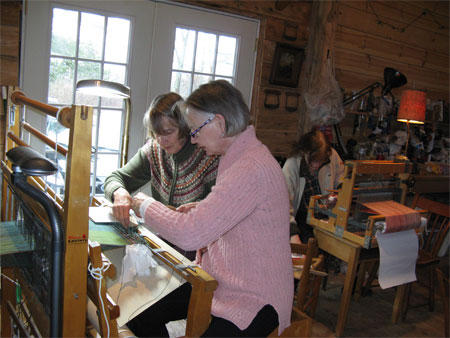I spent Saturday & Sunday at a workshop the Southern Tier Fiberarts Guild sponsored. It was all about doubleweave. We had a small group – only 6 of us, so we were each able to get all sorts of guidance from Pat Edwards, our teacher.

Three of us were working on floor looms, three on table looms.
Here Joan’s warping up her little Mountain loom. The swinging beater was fascinating to me. Hinged at the top and moving freely at the bottom, her hand applied all the pressure, not the beater itself. Interesting.

I rarely work on a table loom myself, but didn’t have a reasonable way to get my beloved floor loom to the workshop site. It’s sweet, small, and light, but doesn’t fold at all, so it’s pretty bulky. Carol was very gracious to loan me her table loom, but there’s nothing like working on a loom you’re familiar with. And there’s really little comparison in shed size between most table looms and most floor looms – floor looms have it beat hands down. Weaving puns intended. 😉
Regardless of the loom used, each of us were working with 4 colors, warped in a straight draw. One side of warp was 2 colors, alternately warped ABAB. The other side was all 4 colors, alternately warped ABCD, ABCD. I wanted high contrast in my warp so I could see the impact of what I was doing, not colors that I necessarily liked or would use in other circumstances. My 2 main colors were a bright orangey-red and a basic blue. The other two were pink and dark purple.

With 4 harnesses, there are six color combinations for top & bottom warp colors. We used each of these combinations, using one of our two main colors for weft.
Carlyn chose colors that all look lovely together, not like my gaudiness.

In addition to the six color combination blocks, Pat taught us how to use doubleweave to weave hinges, tubes, and envelopes.

Doubleweave hinges allow you to make a piece that’s twice as wide as your loom. I’ve used this technique before to make some of my handwoven baby blankets.
Woven tubes come in handy. You can easily make bags & pillows, but if you’re clever and creative, you can do lots more. I’m going to think about a new cowl-hood design that’s tube woven.
I’m less clear on how useful a woven envelope is. Or maybe just less creative in my thinking. Regardless, it is an interesting technique.
After learning how to do those three structures, Pat taught us how to do doubleweave pickup. We each created a little design, called a cartoon, that we’d weave into the cloth. It’s very cool, in that what’s light on the front is dark on the back. Pat encouraged us to keep it simple, to start with angles, not curves.
Here’s my second attempt at color blocks.

I kept messing up on the first, so just considered it all a learning experience, but DON’T need to take pictures of it. You’ll see at a glance that my selvedges are a mess and my beat is uneven. You can pay attention to just so much at one time, and the purpose of this part of the workshop was to learn the doubleweave pickup technique, not to produce a finished product.
I did want to see if I could do curves. Tried my hand at the yin-yang symbol.

Again, not work of quality, but that wasn’t the point; learning was the point.
Val was quite brave, making a little running rabbit for her first attempt at pickup.

While we were all busy learning doubleweave in her cozy studio, Carol decided to weave some yardage using a combination of wool, silk, linen, and (I think) cotton. She plans to dye it in her beautiful natural dyes, then make it into a garment. She knows each of the fibers will take the dye differently, making for some interesting variegation. Whew! I don’t think I’d have the oomph to dye it – the undulating twill with those natural colors is too beautiful for me.

Once I get the handwoven hearts baby blankets off the loom, I plan to do some doubleweave double-width baby blankets in a sweet variegated cotton flannel I have. They’re always popular when I have them in stock.
Gotta go back & hit the couch – I’ve been battling the flu for a week, and it struck back today.


Dear Margret,
I have an 8 shaft Table Loom. It has been a wee while since I used it. I would like to do a double-weave mohair blanket – but the book that came with it, does not stipulate or have diagrams on how to warp up for this purpose. Sadly, the loom is of unknown origin. But the heddles’ levers sit opposite each other on the top most part of the Loom. Does that help? Could you help me? I am running out of time, as this blanket will be a gift in the second week of February.
Regards,
Natasha
Natasha – Sorry it’s taken me so long to get back to you, particularly given your tight time frame – I’ve been out of town playing full-time grandma for a week.
I would recommend against doubleweave with mohair. Mohair is a challenging fiber and doing doubleweave with it will only make it more so. I know that’s not what you want to hear, but it’s my sincere opinion.
FYI, the location of your levers or loom origin has no impact on the loom’s ability to do doubleweave – it’s more about the weaver’s ability than the loom’s. 🙂 Check a good book (Handweaving has a few on doubleweave) or Weavolution if you’re serious about doubleweave — preferable with a different fiber.
Or, weave it single width but twice as long and then hand weave/sew the two strips together.
Good luck!
Peg
[…] Margaret Cherre Contributing Member Latest Blog:Doubleweave Workshop […]